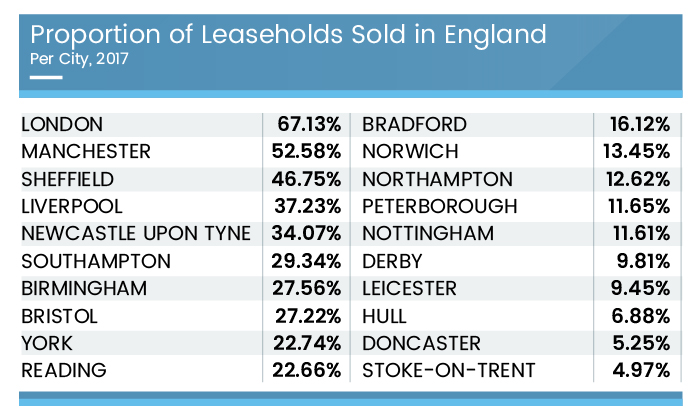Sellhousefast.uk investigates the sales of leasehold properties in England and Wales in light of the Government’s crackdown of ‘unfair and abusive practices within the leasehold system’
Sellhousefast.uk analysed data from the Land Registry on properties sold in 2017, also looking at the data for previous years and found that the leasehold system is very much alive in both England and Wales.
Analysis of the Land Registry’s data reveals that leaseholds accounted for 31.9% of all properties sold in England and Wales in 2017. In 2016, leasehold properties accounted for 26.9% of all properties sold. That’s a 1.2% increase from 2015 when leaseholds made up 25.7% of the property market.
They also found that of 219,511 leaseholds sold in 2017, 84.1% were existing properties and just 15.9% were new-builds. Of all the flats sold in 2017, only 2.13% were freeholds, which means that freehold flats are virtually non-existent.
Sellhousefast.uk looked at the share of leaseholds sold in the largest English cities in 2017 and found major differences. The leasehold system was found to be most widespread in London and Manchester where leaseholds accounted for 67.13% and 52.58% of all properties sold, respectively. Sheffield had the third largest share of leasehold properties – 46.75%, followed by Liverpool (37.23%) and Newcastle upon Tyne (34.07%).
With leaseholds accounting for just 4.97% of all properties sold, Stoke-on-Trent was found to be the freehold capital of England. With leaseholds making up only 5.25% of the total property market, Doncaster closely fell behind Stoke-on-Trent. Doncaster was followed by Hull (6.88%), Leicester (9.45%) and Derby (9.81%).
A similar situation was observed in Wales, who are still waiting for a solution for the leasehold issue. With leaseholds accounting for 35.12% of all properties sold in 2017, Neath was found to have the highest proportion of leasehold properties sold in the country. The Welsh capital of Cardiff had the second highest proportion of leasehold properties (24.32%), followed by Swansea (19.19%), Newport (14.19) and Barry (12.80%).
With leaseholds accounting for less than 3% – 2.95%, Merthyr Tydfil was the least “leasehold-affected” city in Wales in 2017, followed by Llanelli (3.84%), Bridgend (5.56%), Wrexham (8.92%) and Cwmbran (10.75%).
Robby Du Toit, MD from Sellhousefast.uk commented: “We are yet to see how the Government will solve the issue of the existing leaseholders and how the latest measures will affect the property market.
“I’m afraid that existing leaseholders will probably have to lower the asking price considerably if they want to sell. I can’t imagine who will want to buy a property with preposterous ground rents, especially now that the Government promised to set the ground rents on new long leases – for both flats and houses – to zero.
“Another thing that worries me is that a lot of leaseholds are held by investors who obviously want to make the most out of their investment. I’m concerned that they might try to exploit the loopholes in the new measures to continue to profit from the leasehold system.”












